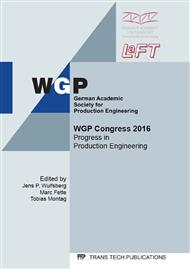p.304
p.312
p.320
p.328
p.337
p.345
p.353
p.361
p.369
Simulating the Bearing Load due to Unbalance in Wood Machining Tools
Abstract:
To realise the high cutting speeds required in wood machining for a productive cutting process, high-speed spindles are used especially in CNC machining centres. The high rotational speed during operation, however, results in great centrifugal forces at the tool. Particularly unbalance here leads to a great loading of the spindle bearing as well as to reduced occupational safety. Unlike metal removal, the machining of wood and engineered wood products is subject to other requirements regarding the process parameters, such as e.g. higher cutting speeds or material removal rates. For that reason, economical sensible balance qualities for tools in wood machining are analysed within the IGF project 18381 N „Establishing the necessary balance quality of tools in wood machining“, which is carried out in cooperation with a working group from industry and funded by the Federal Ministry for Economic Affairs and Energy (BMWi). In order to analyse how unbalances in tools influences the loads of the spindle bearing, a simulation model of a spindle will be developed and constructed for wood machining. Serving as a basis of the model, the frequency responses of the static spindle will be established by experiment. Based on this, the natural vibration behaviour of the spindle will be simulated in a finite element model. Finally, it will be presented how test tools with different balance conditions influence the bearing load of the spindle.
Info:
Periodical:
Pages:
337-344
Citation:
Online since:
August 2016
Authors:
Keywords:
Price:
Сopyright:
© 2016 Trans Tech Publications Ltd. All Rights Reserved
Share:
Citation:


